Themed collection Bioactive surfaces for hard tissue regeneration

Bioactive surfaces for hard tissue regeneration
Welcome to this themed issue of RSC Advances on bioactive surfaces for hard tissue regeneration.

RSC Adv., 2013,3, 11057-11057
https://doi.org/10.1039/C3RA90065G
Application of plasma electrolytic oxidation to bioactive surface formation on titanium and its alloys
A review of the literature concerning the surface modification of titanium by plasma electrochemical oxidation is presented.
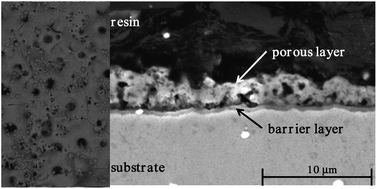
RSC Adv., 2013,3, 19725-19743
https://doi.org/10.1039/C3RA43465F
Bioactive ceramics: from bone grafts to tissue engineering
The pathway followed by bioactive ceramics from their early use as bone grafts until the present day, where they are widely investigated to obtain porous scaffolds for bone tissue engineering, is reviewed.
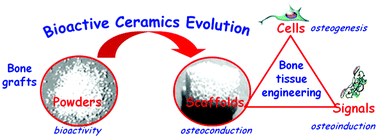
RSC Adv., 2013,3, 11116-11131
https://doi.org/10.1039/C3RA00166K
Scaffolds for bone tissue engineering: role of surface patterning on osteoblast response
This review documents the plethora of biomaterials for bone tissue engineering applications in tandem with experimental and brief theoretical studies on cell responses on textured substrates.
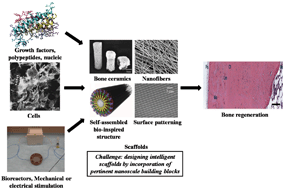
RSC Adv., 2013,3, 11073-11094
https://doi.org/10.1039/C3RA23315D
Recent progress in the field of multicomponent bioactive nanostructured films
Multicomponent bioactive nanostructured films (MuBiNaFs) with an excellent combination of various properties were developed and deposited by sputtering of composite targets produced via the self-propagating high-temperature synthesis method.
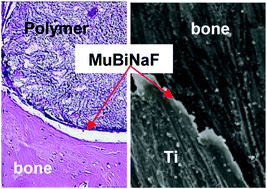
RSC Adv., 2013,3, 11107-11115
https://doi.org/10.1039/C3RA23325A
Inorganic material surfaces made bioactive by immobilizing growth factors for hard tissue engineering
This review summarizes the methods for immobilization of growth factors on inorganic materials for hard tissue engineering.
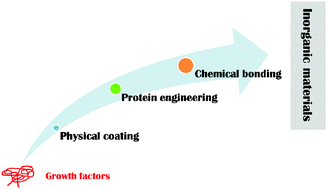
RSC Adv., 2013,3, 11095-11106
https://doi.org/10.1039/C3RA23313H
Carbon nanostructures for hard tissue engineering
Utilizing carbon nanostructures as high-performance scaffold materials in hard tissue engineering is both promising and challenging.
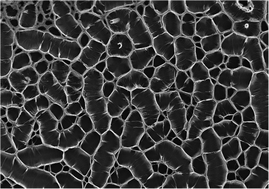
RSC Adv., 2013,3, 11058-11072
https://doi.org/10.1039/C2RA23306A
Synthesis and characterization of hydroxyapatite on hydrolyzed polyacrylonitrile nanofiber templates
Non-cytotoxic bioactive composite fibers were synthesized on electrospun nanofibers containing amine and carboxyl groups on the surface.
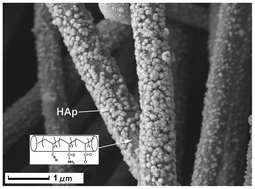
RSC Adv., 2013,3, 11132-11139
https://doi.org/10.1039/C3RA23264F
BMP2-loaded nanoporous silica nanoparticles promote osteogenic differentiation of human mesenchymal stem cells
Nanoporous silica nanoparticles with immobilized BMP2 as depicted in the scheme effectively promote osteogenic differentiation of mesenchymal stem cells.
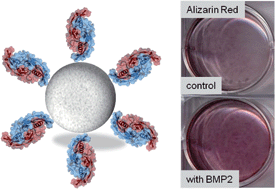
RSC Adv., 2013,3, 24222-24230
https://doi.org/10.1039/C3RA44734K
A bioactive Ti metal with a Ca-enriched surface layer releases Mg ions
A bioactive surface layer that released Mg2+ ions was produced on the surface of titanium metal (Ti) by chemical and heat treatments.

RSC Adv., 2013,3, 11274-11282
https://doi.org/10.1039/C3RA00054K
Biomimetic calcium–phosphates produced by an auto-catalytic route on stainless steel 316L and bio-inert polyolefin
Calcium-phosphate by new autocatalytic bath on 316L and PP-PE improves cells density in PP-PE (A) and 316L (C) compared to the untreated PP-PE (B) and 316 L (D).
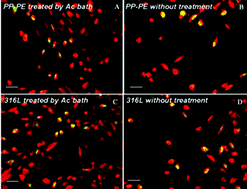
RSC Adv., 2013,3, 11255-11262
https://doi.org/10.1039/C3RA23385E
Crystal structure and chemical composition of biomimetic calcium phosphate nanofibers
A structural and chemical analysis of nanofibers synthesized via interfacial mineralization of calcium phosphate beneath monolayers of poly(n-butylmethacrylate)-block-poly[2-(dimethylamino)ethyl methacrylate] at the air–water interface.
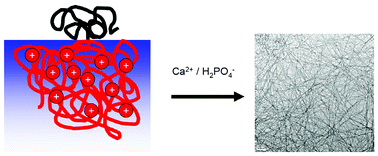
RSC Adv., 2013,3, 11301-11308
https://doi.org/10.1039/C3RA23348K
Titania nanotube porosity controls dissolution rate of sputter deposited calcium phosphate (CaP) thin film coatings
Titanium nanotube porosity to control the dissolution of sputter deposited calcium phosphate thin films.
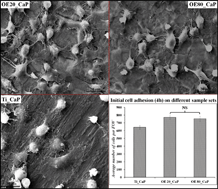
RSC Adv., 2013,3, 11263-11273
https://doi.org/10.1039/C3RA40898A
MiR-148b laden titanium implant promoting osteogenic differentiation of rat bone marrow mesenchymal stem cells
Functionalizing titanium (Ti) implants with bioactive agents appears to be attractive for accelerating osseointegration.
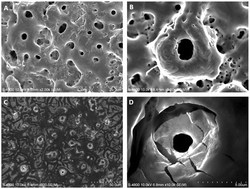
RSC Adv., 2013,3, 11292-11300
https://doi.org/10.1039/C3RA00007A
Inner surface modification of the tube-like elements for medical applications
Novel aspects are polymer tubes for external and internal blood circulation modified with non-cytotoxic and anti-thrombogenic coatings tested through advanced interdisciplinary biophysical investigations on blood in patient-like conditions.
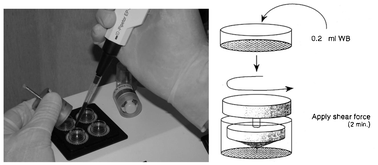
RSC Adv., 2013,3, 11283-11291
https://doi.org/10.1039/C3RA23159C
Preparation of a silicate-containing hydroxyapatite-based coating by magnetron sputtering: structure and osteoblast-like MG63 cells in vitro study
Silicate-containing hydroxyapatite-based coatings with different structure and calcium/phosphate ratios were prepared by rf-magnetron sputtering.
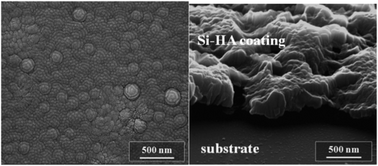
RSC Adv., 2013,3, 11240-11246
https://doi.org/10.1039/C3RA40446C
Electrophoretic deposition of nanostructured-TiO2/chitosan composite coatings on stainless steel
Novel bioactive nanostructured-TiO2/chitosan coatings obtained by electrophoretic deposition with tailored contact angle and corrosion protection for orthopaedic devices.
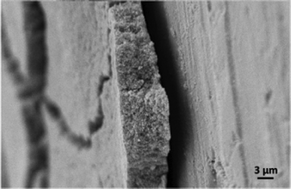
RSC Adv., 2013,3, 11247-11254
https://doi.org/10.1039/C3RA40535D
Morphology and structure of antibacterial nanocomposite organic–polymer and metal–polymer coatings deposited from active gas phase
The synthesis of nanocomposite polymer-based coatings was produced from active gas phase formed by electron beam dispersion of polymer and biocide agent in vacuum.
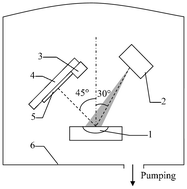
RSC Adv., 2013,3, 11226-11233
https://doi.org/10.1039/C3RA23284K
Enhanced bioactivity and bacteriostasis effect of TiO2 nanofilms with favorable biomimetic architectures on titanium surface
TiO2 nanofilms on a titanium surface prepared by hydrothermal treatment are of hierarchical architectures and exhibit improved bioactivity and bacteriostasis.
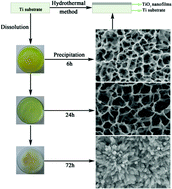
RSC Adv., 2013,3, 11214-11225
https://doi.org/10.1039/C3RA23252B
Osteoblast responses to novel titanium-based surfaces produced by plasma- and ion beam technologies
Novel Ti-based layers prepared by plasma and ion beam technologies were demonstrated to have good cytocompatibility and are suitable for application in biomedicine.
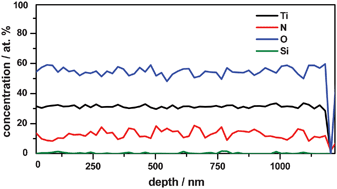
RSC Adv., 2013,3, 11205-11213
https://doi.org/10.1039/C3RA23351K
Alginate/silica composite hydrogel as a potential morphogenetically active scaffold for three-dimensional tissue engineering
Bead-encapsulation of bone cells is a useful technique to produce bioactive programmable hydrogels.
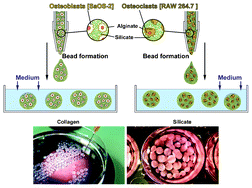
RSC Adv., 2013,3, 11185-11194
https://doi.org/10.1039/C3RA23341C
Formation of bioactive coatings on Ti–13Nb–13Zr alloy for hard tissue implants
We obtain a bioactive coating on the Ti–13Nb–13Zr alloy via plasma electrolytic oxidation and additional alkali treatment.
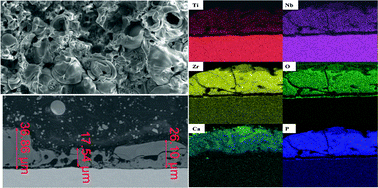
RSC Adv., 2013,3, 11195-11204
https://doi.org/10.1039/C3RA23256E
Deposition and characterization of a dual-layer silicon- and silver-containing hydroxyapatite coating via a drop-on-demand technique
Silicon-containing hydroxyapatite (SiHA) and silver-containing hydroxyapatite (AgHA) have been shown to provide enhanced bioactivity and antibacterial properties over pure hydroxyapatite (HA), respectively.
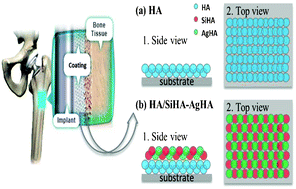
RSC Adv., 2013,3, 11162-11168
https://doi.org/10.1039/C3RA23251D
Enhanced osteoblast functions of narrow interligand spaced Sr-HA nano-fibers/rods grown on microporous titania coatings
Nanofibrous and nanorod-shaped Sr1-HA with lateral spacing of less than 100 nm, and nanogranulated Ca0.5Sr0.5TiO3 were hydrothermally grown on micro-arc oxidized microporous and nanocrystallized TiO2, respectively, to form multilayer coatings.
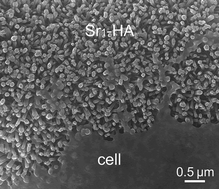
RSC Adv., 2013,3, 11169-11184
https://doi.org/10.1039/C3RA23425H
Influence of precursor chemistry on CVD grown TiO2 coatings: differential cell growth and biocompatibility
Titania (TiO2) films of different phase compositions and surface topographies grown from chemically different precursors showed markedly different bioresponses, manifested in differential cell growth and proliferation behaviour.
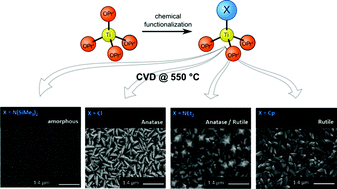
RSC Adv., 2013,3, 11234-11239
https://doi.org/10.1039/C3RA00050H
A genetically active nano-calcium phosphate paste for bone substitution, encoding the formation of BMP-7 and VEGF-A
Calcium phosphate nanoparticles with different compositions and morphologies were prepared and loaded with DNA. These nanoparticles can be used for transfection of different cell types and are highly biocompatible.
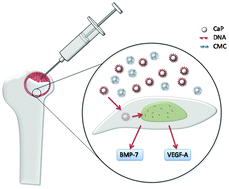
RSC Adv., 2013,3, 11155-11161
https://doi.org/10.1039/C3RA23450A
Human osteoblast-like cells response to pulsed electrodeposited calcium phosphate coatings
The biocompatibility of a calcium phosphate coating synthesized by pulsed electrodeposition is assessed by observing its behaviour in contact with human osteoblast-like cells (MG-63).
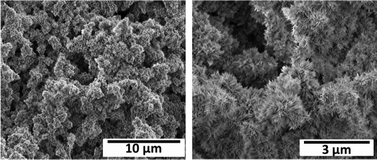
RSC Adv., 2013,3, 11148-11154
https://doi.org/10.1039/C3RA23255G
An approach to a biomimetic bone scaffold: increased expression of BMP-2 and of osteoprotegerin in SaOS-2 cells grown onto silica-biologized 3D printed scaffolds
SaOS-2 cells growing on 3D printed grids formed of silica-impregnated Ca-sulfate retain the ability to express osteoprotegerin and BMP-2, suggesting that 3D printed matrices, processed with silica, might function also as a morphogenetic material in vivo.
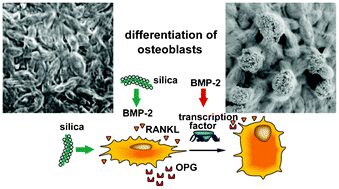
RSC Adv., 2013,3, 11140-11147
https://doi.org/10.1039/C2RA22352J
About this collection
Welcome to this themed collection on 'Bioactive surfaces for hard tissue regeneration', Guest Edited by Professor Matthias Epple (University of Duisburg-Essen, Essen, Germany) and Professor Roman Surmenev (National Research Tomsk Polytechnic University, Tomsk, Russia).